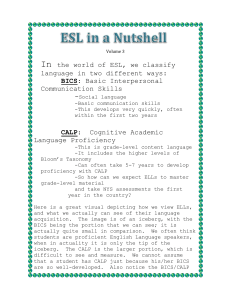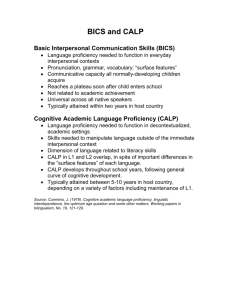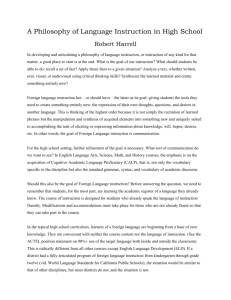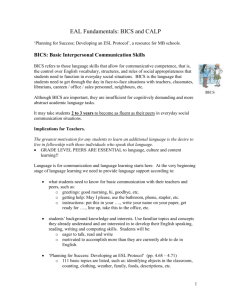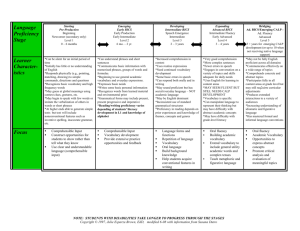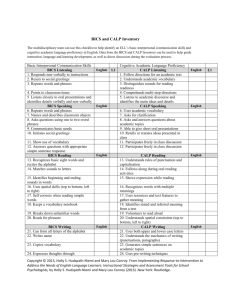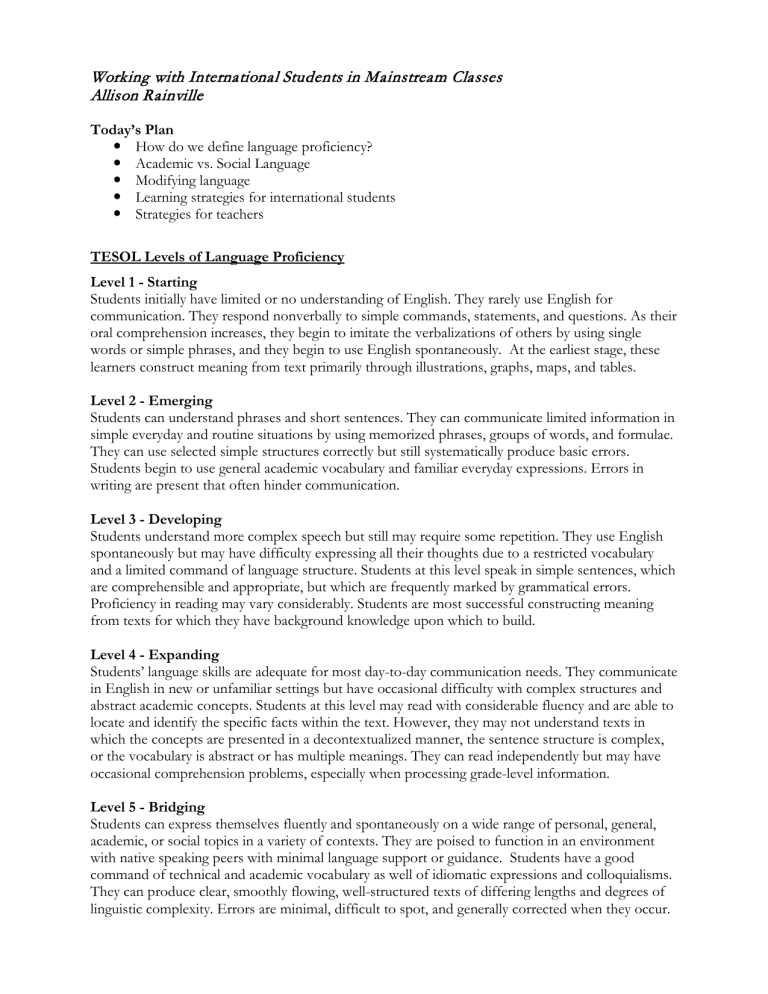
Working with International Students in Mainstream Classes Allison Rainville Today’s Plan How do we define language proficiency? Academic vs. Social Language Modifying language Learning strategies for international students Strategies for teachers TESOL Levels of Language Proficiency Level 1 - Starting Students initially have limited or no understanding of English. They rarely use English for communication. They respond nonverbally to simple commands, statements, and questions. As their oral comprehension increases, they begin to imitate the verbalizations of others by using single words or simple phrases, and they begin to use English spontaneously. At the earliest stage, these learners construct meaning from text primarily through illustrations, graphs, maps, and tables. Level 2 - Emerging Students can understand phrases and short sentences. They can communicate limited information in simple everyday and routine situations by using memorized phrases, groups of words, and formulae. They can use selected simple structures correctly but still systematically produce basic errors. Students begin to use general academic vocabulary and familiar everyday expressions. Errors in writing are present that often hinder communication. Level 3 - Developing Students understand more complex speech but still may require some repetition. They use English spontaneously but may have difficulty expressing all their thoughts due to a restricted vocabulary and a limited command of language structure. Students at this level speak in simple sentences, which are comprehensible and appropriate, but which are frequently marked by grammatical errors. Proficiency in reading may vary considerably. Students are most successful constructing meaning from texts for which they have background knowledge upon which to build. Level 4 - Expanding Students’ language skills are adequate for most day-to-day communication needs. They communicate in English in new or unfamiliar settings but have occasional difficulty with complex structures and abstract academic concepts. Students at this level may read with considerable fluency and are able to locate and identify the specific facts within the text. However, they may not understand texts in which the concepts are presented in a decontextualized manner, the sentence structure is complex, or the vocabulary is abstract or has multiple meanings. They can read independently but may have occasional comprehension problems, especially when processing grade-level information. Level 5 - Bridging Students can express themselves fluently and spontaneously on a wide range of personal, general, academic, or social topics in a variety of contexts. They are poised to function in an environment with native speaking peers with minimal language support or guidance. Students have a good command of technical and academic vocabulary as well of idiomatic expressions and colloquialisms. They can produce clear, smoothly flowing, well-structured texts of differing lengths and degrees of linguistic complexity. Errors are minimal, difficult to spot, and generally corrected when they occur. Second Language Acquisition • • __________________________________________________ • i+1 • Input (i) needs to be __________________, with a little information that is _______________ the student’s level (+1) • i + 1 input will help students acquire language more quickly AND will help students understand the input ____________________________________________ • The order in which grammar concepts are acquired BICS/CALP BICS = __________________________________________________________ BICS is the language that is used in ____________________ _____________________________________ _____________________________________ Acquired in ________ years _____________________________________ _____________________________________ CALP = __________________________________________________________ CALP is the language that is used in __________________ _____________________________________ _____________________________________ Acquired in ________ years _____________________________________ _____________________________________ BICS/CALP Exercise 2: ______________________________________________________________________________ ______________________________________________________________________________ ______________________________________________________________________________ ______________________________________________________________________________ Academic Language Content-specific language: General academic language • ____________________________ • ____________________________ • ____________________________ • ____________________________ • ____________________________ Modifying Academic Language Look at language use in your classroom: ________________________ ___________________________ ______________________________________________________________ ________________________ ___________________________ ___________________________ ______________________________________________________ ___________________________ What kinds of language are “difficult?” • ______________________________________________________ • ______________________________________________________ • ______________________________________________________ • ______________________________________________________ • ______________________________________________________ Now you try… Directions: Rewrite the following questions to make them easier for lower-level students to understand: English/Literature 1. What impression do you get of Jean from her relationship with her mother and brothers? ______________________________________________________________________________ ______________________________________________________________________________ 2. This story is told from the point of view of a ten-year-old. a. How does the author convince you that Bennie’s perceptions are those of a child? b. What aspects of the adult world are beyond Bennie’s grasp? ______________________________________________________________________________ ______________________________________________________________________________ ______________________________________________________________________________ ______________________________________________________________________________ Science 1. Why do we say that surface water is both a creator and destroyer of sediments and sedimentary rocks? ______________________________________________________________________________ ______________________________________________________________________________ 2. If a single disturbance some unknown distance away sends out both transverse and longitudinal waves that travel with distinctly different speeds in the medium, such as in the ground during earthquakes, how could the origin of the disturbance be located? ______________________________________________________________________________ ______________________________________________________________________________ ______________________________________________________________________________ ______________________________________________________________________________ Math 1. A space probe leaves the Earth at the rate of 3 km/s. After 100 days, a radio signal is sent to the probe. Radio signals travel at the speed of light, about 3 X 105 km/s. About how long does the signal take to reach the probe? ______________________________________________________________________________ ______________________________________________________________________________ ______________________________________________________________________________ 2. A tortoise crawling at the rate of 0.1 mi/h passes a resting hare. The hare wants to rest another 30 min before chasing the tortoise at the rate of 5 mi/h. How many feet must the hare run to catch the tortoise? ______________________________________________________________________________ ______________________________________________________________________________ ______________________________________________________________________________ History 1. Compare the leadership of Philip II of Spain and Henry IV of France. (a) What were the objectives of each? (b) How well did each succeed? (c) What legacy did each leave to his kingdom? ______________________________________________________________________________ ______________________________________________________________________________ ______________________________________________________________________________ 2. What part did each of the following play in imperialism? (a) markets (b) raw materials (c) national pride ______________________________________________________________________________ ______________________________________________________________________________ ______________________________________________________________________________ Specific learning strategies that are relevant to my students (and that I can teach them): ______________________________________________________________________________ ______________________________________________________________________________ ______________________________________________________________________________ ______________________________________________________________________________ ______________________________________________________________________________ Teaching strategies that I feel I can use, or that I am intrigued enough to try: ______________________________________________________________________________ ______________________________________________________________________________ ______________________________________________________________________________ ______________________________________________________________________________ ______________________________________________________________________________ Additional Notes ______________________________________________________________________________ ______________________________________________________________________________ ______________________________________________________________________________ ______________________________________________________________________________ ______________________________________________________________________________ ______________________________________________________________________________ ______________________________________________________________________________ ______________________________________________________________________________ ______________________________________________________________________________ ______________________________________________________________________________
